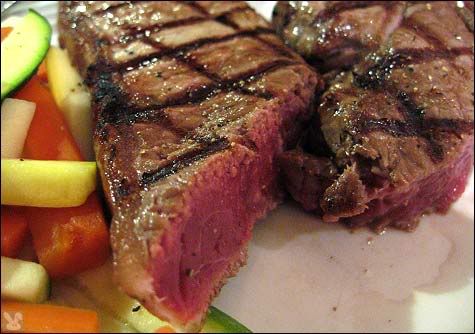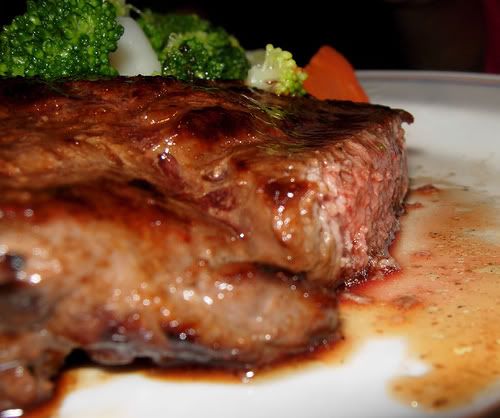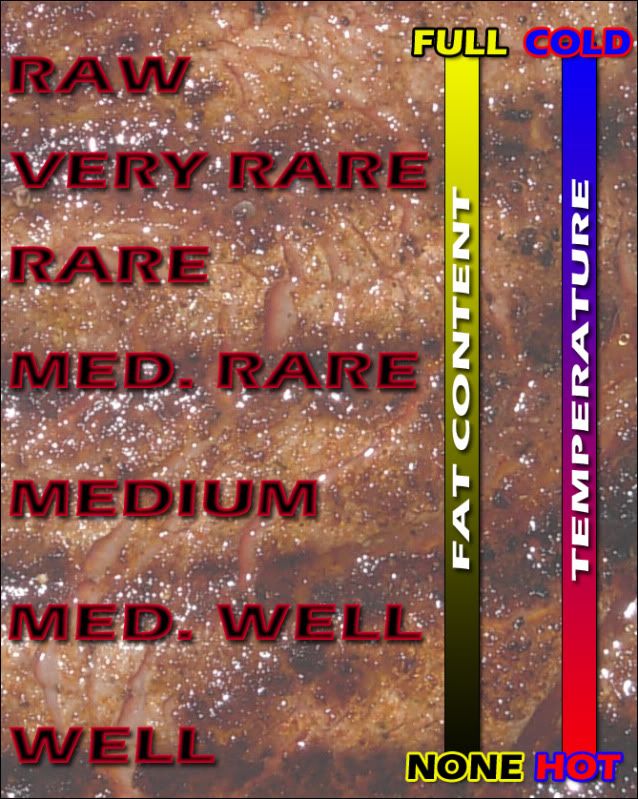If you're a regular reader of this blog, then you've undoubtedly learned a thing or two about steak.There's one subject concerning nature's most perfect food that I've avoided, and for good reason. That subject is: degree of cooking.
Degree of cooking (or "steak doneness") is a divisive topic to say the least. Everyone has their opinion. I'm normally a very live and let live kinda guy... tastes vary, and if you like something a certain way then that's the way you should have it. However, I have a real problem with one-half of the doneness debate, which I'm addressing now.
There are two kinds of people when it comes to degree of cooking, as illustrated in the following images:
and
As if you couldn't have guessed by the title of this post, I'm firmly in the first camp. However, I try not to be an asshole about it. There are a lot of myths and misconceptions about steak doneness and, as a result, cooking and eating meat in general. It is these misconceptions that lead most people to request and then consume poorly prepared (overcooked) steak. It's akin to ordering a soggy bowl of cereal. These myths also keep many people from ever trying a properly prepared steak, for fear of death.
My aim is to address the four myths that cause most people to shy away from eating a properly cooked steak, starting with the biggest one of all, which I will now indicate with bold text and a large font.
Myth #1: Medium rare steak will make you sick
 |
| These are not in steak |
Myth #2: There are five degrees of cooking a steak
 |
| This is not a rare steak |
Myth #3: Medium rare steak is bloody
 |
| This is not blood |
Myth #4: Steak isn't done until it's brown
Brownness doesn't equal doneness. As it said above, brownness is just the myoglobin reacting to prolonged temperatures. There's really no such thing as a steak being "done", again, because it's based entirely on taste. Your steak is done when it tastes the way you want it to taste. Which brings me to the biggest point I'd like to make: To the vast majority of people, a medium rare steak tastes better than a steak cooked longer. Period. The two biggest contributors to flavor outside of the quality of the meat is physical temperature and fat content. Fat makes a steak taste good, and the longer you cook your steak, the more fat you lose. However, very few people want to eat cold or even cool meat. So, since fat and temperature are inversely proportional, we need to find the middle point between temperature and fat loss. Consulting the handy chart to the left, we see that middle point is medium rare: You have a nice, warm center with a moderately high fat content.
If it seems simple, good. It is. If you're waiting for the other shoe to drop... it isn't coming. Unfortunately, the preponderance of these myths keep people from even attempting to eat a steak that isn't cooked to medium well or longer. A famous chef once said, "A well done steak is for people who don't like steak."
If you normally order your steak between medium and well done, think back to all of the steaks you've eaten in your life. Have you ever eaten a steak that was truly outstanding, with a taste better than others you've had? Probably not. Medium to well-done steaks, in truth, all taste the same: like generic cooked meat. It's good, sure... but it's not great.
I hope I've convinced you to do yourself a favor and have your next steak medium rare. You won't get sick, you won't be consuming undercooked meat or blood, and most importantly, it might change your life. Your food life, anyway.





This was incredibly useful. I'm posting it to my facebook on wednesday!
ReplyDeleteQuick question from a frequent reader,
can you please remove the text verification thing? The spam filter is pretty good, and it's just a hassle for the rest of us.
Done.
ReplyDeleteThis comment has been removed by a blog administrator.
ReplyDeleteMedium Rare all the way!!!!
ReplyDeleteSeasoning minimal, no globby sauce either.
For some people (like me), it's a texture issue. I love me some medium wellington, but I also really like steak tartar and sometimes crave rare hamburgers. I craved raw hamburger most of my pregnancy. I just really don't enjoy a steak cooked less than medium because of the texture in my mouth.
ReplyDelete